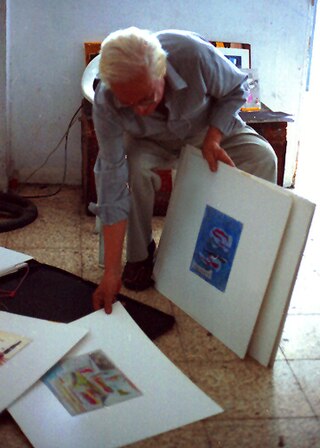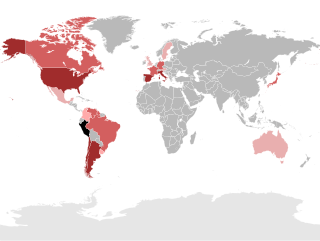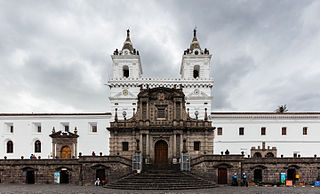
Demographic features of the population of Ecuador include population density, ethnicity, education level, health of the populace, economic status, religious affiliations and other aspects of the population.

Mestizo is a person of mixed European and Indigenous non-European ancestry in the former Spanish Empire. In certain regions such as Latin America, it may also refer to people who are culturally European even though their ancestors are Indigenous. The term was used as an ethno-racial exonym for mixed-race castas that evolved during the Spanish Empire. It was a formal label for individuals in official documents, such as censuses, parish registers, Inquisition trials, and others. Priests and royal officials might have classified persons as mestizos, but individuals also used the term in self-identification. With the Bourbon reforms and the independence of the Americas, the caste system disappeared and terms like "mestizo" fell in popularity.
Peruvian culture is the gradual blending of Amerindian cultures with European and Asian ethnic groups. The ethnic diversity and rugged geography of Peru allowed diverse traditions and customs to co-exist. Peruvian culture has been deeply influenced by Native culture, Spanish culture, and Asian culture. Other minor influences on their culture are Chinese, Japanese, and other European peoples.

Cholo is a loosely defined Spanish term that has had various meanings. Its origin is a somewhat derogatory term for people of mixed-blood heritage in the Spanish Empire in Latin America and its successor states as part of castas, the informal ranking of society by heritage. Cholo no longer necessarily refers only to ethnic heritage, and is not always meant negatively. Cholo can signify anything from its original sense as a person with one indigenous parent and one Mestizo parent, "gangster" in Mexico, an insult in some South American countries, or a "person who dresses in the manner of a certain subculture" in the United States as part of the cholo subculture.

Spanish colonial architecture represents Spanish colonial influence on the cities and towns of its former colonies, and is still seen in the architecture as well as in the city planning aspects of conserved present-day cities. These two visible aspects of the city are connected and complementary. The 16th-century Laws of the Indies included provisions for the layout of new colonial settlements in the Americas and elsewhere.

Luis Enrique Tábara was a master Ecuadorian painter and teacher representing a whole Hispanic pictorial and artistic culture.

In Hispanic America, criollo is a term used originally to describe people of full Spanish descent born in the viceroyalties. In different Latin American countries, the word has come to have different meanings, mostly referring to the local-born majority. Historically, they have been misportrayed as a social class in the hierarchy of the overseas colonies established by Spain beginning in the 16th century, especially in Hispanic America. They were locally-born people–almost always of Spanish ancestry, but also sometimes of other European ethnic backgrounds.
Peruvian art has its origin in the Andean civilizations. These civilizations rose in the territory of modern Peru before the arrival of the Spanish.
The culture of Latin America is the formal or informal expression of the people of Latin America and includes both high culture and popular culture, as well as religion and other customary practices. These are generally of Western origin, but have various degrees of Native American, African and Asian influence.

Spanish Baroque is a strand of Baroque architecture that evolved in Spain, its provinces, and former colonies.

Peruvians are the citizens of Peru. What is now Peru has been inhabited for several millennia by cultures such as the Caral before the Spanish conquest in the 16th century. Peruvian population decreased from an estimated 5–9 million in the 1520s to around 600,000 in 1620 mainly because of infectious diseases carried by the Spanish. Spaniards and Africans arrived in large numbers in 1532 under colonial rule, mixing widely with each other and with Native Peruvians. During the Republic, there has been a gradual immigration of European people. Chinese and Japanese arrived in large numbers at the end of the 19th century.
Latin American art is the combined artistic expression of Mexico, Central America, the Caribbean, and South America, as well as Latin Americans living in other regions.

The Cusco school or Cuzco school, was a Roman Catholic artistic tradition based in Cusco, Peru during the Colonial period, in the 16th, 17th and 18th centuries. It was not limited to Cusco only, but spread to other cities in the Andes, as well as to present day Ecuador and Bolivia.

The Basilica and Convent of San Francisco, commonly known as el San Francisco, is a Catholic basilica that stands in the middle of the historic center of Quito, in front of the square of the same name. It is the oldest and most significant religious site in Ecuador. The structure is the largest architectural complex within the historic centers of all of South America, and for this reason it was known as "El Escorial of the New World". San Francisco is considered a jewel of continental architecture for its mixture of different styles combined throughout more than 150 years of construction. San Francisco is part of the UNESCO World Heritage Site "City of Quito".

The architecture of Mexico reflects the influences of various cultures, regions, and periods that have shaped the country's history and identity. In the pre-Columbian era, distinct styles emerged that reflected the distinct cultures of the indigenous peoples of Mexico, particularly in the architecture of Mesoamerica. During the colonial era, the region was transformed by successive styles from Europe. With the foremost style during this era being Mexican Baroque.

The Quito School is a Latin American colonial artistic tradition that constitutes essentially the whole of the professional artistic output developed in the territory of the Royal Audience of Quito – from Pasto and Popayán in the north to Piura and Cajamarca in the south – during the Spanish colonial period (1542–1824). It is especially associated with the 17th and 18th centuries and was almost exclusively focused on the religious art of the Catholic Church in the country. Characterized by a mastery of the realistic and by the degree to which indigenous beliefs and artistic traditions are evident, these productions were among of the most important activities in the economy of the Royal Audience of Quito. Such was the prestige of the movement even in Europe that it was said that King Carlos III of Spain (1716–1788), referring to one of its sculptors in particular, opined: "I am not concerned that Italy has Michelangelo; in my colonies of America I have the master Caspicara".

Bolivians are people identified with the country of Bolivia. This connection may be residential, legal, historical or cultural. For most Bolivians, several of these connections exist and are collectively the source of their being Bolivian.

Andean Baroque is an artistic movement that appeared in colonial Peru between 1680 and 1780. It is located geographically between Arequipa and Lake Titicaca in what is now Peru, where rules over the highlands and spreads over the entire altiplano. From the Portuguese word barrueco meaning impure, mottled, flamboyant, daring, the most striking example of Andean Baroque art is in religious architecture, where criollo and indigenous craftsmen together gave it a unique character, as happened in the New Spanish Baroque.

Various types of visual arts developed in the geographical area now known as Mexico. The development of these arts roughly follows the history of Mexico, divided into the prehispanic Mesoamerican era, the colonial period, with the period after Mexican War of Independence, the development Mexican national identity through art in the nineteenth century, and the florescence of modern Mexican art after the Mexican Revolution (1910-1920).

Indochristian art, is a type of Latin American art that combines European colonial influences with Indigenous artistic styles and traditions.

















